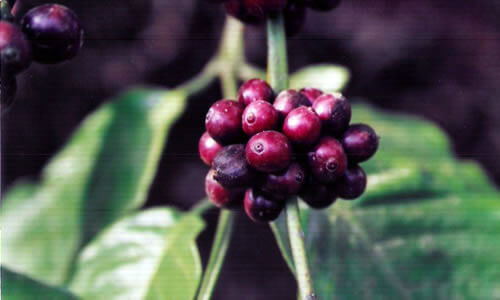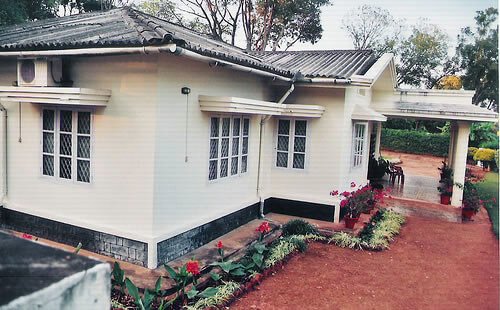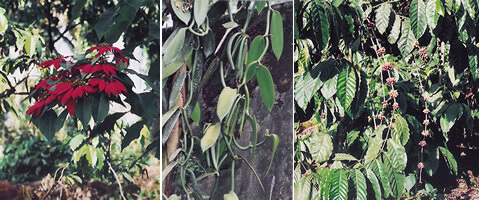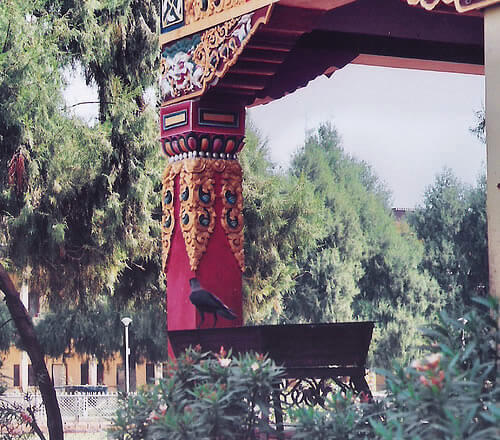Travel on the Coffee Trail in India
Article and photos by Lu-Sa-Ka

|
|
Coffee beans — close up.
|
As the car made its way up the steep inclines of the hilly terrain of Coorg, I could not help but think of Baba Budan. Way back in the mid 1600’s this holy man, brought back seven germinable coffee beans with him, while returning from a pilgrimage in Arabia. Since then, coffee plants have been flourishing in the hilly region of not just Chikmagalur — where he planted them — but the entire region of Coorg. The Baba Budan range is steeped in history and its slopes are redolent with green bushes of fine Arabica and Robusta, the two variants of coffee grown here. Had it not been for his resourcefulness, we would not be heading towards the coffee plantations today.
Onward to the Coffee Plantations: One should spend a day or two exploring Bangalore, India, which is well-connected by air (international and domestic) and rail before embarking on the coffee trail by road.
An early breakfast and start in Bangalore will help beat the afternoon sun. The typical 6-hour route will take you through: Bangalore, Channapatna (known for its wooden toys, including dolls with nodding heads, all brightly painted and making for some cheerful souvenirs); Mandya (an agricultural district); Mysore (a historical tourist spot); Kushalnagara (the district closest to the Golden Temple, Bylakuppe) and finally Coorg — the land of coffee.
While several eating joints dot the Bangalore-Mysore Highway, stopping at Kamat’s Lokaruchi, soon after Channapatna, is an experience in itself. Resembling a kitchen of an era gone by, it serves authentic vegetarian food from the various Southern States of India.
Cups of Robusta coffee: As the air begins to get cooler and the roads steeper and curvaceous, it is a clear sign that you have hit the Baba Budan range and are headed towards Polibetta (South Coorg), where the "Plantation Trails" coffee estate lies.
Colonial cottages, where British planters once lived, dot this estate. Today these cottages provide the right blend of a home stay and a plantation stay. The rooms and even the bathrooms are massive, with high ceilings, teak furniture and in some cottages even a fireplace. Each cottage has its own dedicated staff, we stayed in a comparatively smaller but cozier cottage manned by Krishna and Lokesh, and the cook was dubbed Abdul Kalam because he had a white flowing mane. I never found out his real name. The trio oozed hospitality.

|
|
Cottage at Plantation Trails.
|
While guests have to share a common dining hall and drawing room, meals are made according to preference and served when you want them. A must try is the vegetable stew spiced with cinnamon, cardamom and served with appamas (fluffy pancakes), or you may substitute the vegetable stew for pork curry or chicken curry. Needless to add, an endless supply of cups of Robusta coffee grown on this estate is available and served with a smile.
A complimentary excursion of the plantation in an open jeep is thrown in. In December, the fully grown bright red Robusta coffee beans shone on the bushes. Picking, all done by hand, would start in full swing from January onwards. One wonders why there are so many trees on the plantation. The answer is simple. Coffee bushes require shade, and to further optimize the use of the land, pepper plants twine up the trees. Other crops that are inter-planted along with coffee are cardamom and increasingly vanilla, given the demand for this fragrant bean. The Christmas festive plant poinsettias grow wild in the estates providing an added color in nooks and crannies. The aroma of vanilla, pepper, and coffee that was being dried along with the smell of the wet earth would fetch a premium in the perfume industry.

|
|
Left to right: wild poinsettias, vanilla bean plant, and a coffee bush.
|
Even though a walk in the moonlight may seem enticing, it is best not to set out on your own. Wild elephants are known to occasionally venture into the estate foraging for jackfruits and papayas. Early mornings are best reserved for bird watching, as many as 300 species of birds are said to be found here. However, bird watching is not as easy as it sounds. Occasional streaks of yellow, across the sky, indicate that a Golden Oriole has just flown by. Besides the noisy parakeets most birds seem shy of human company and cameras. Yet, serene as it all is, the demands of city-loving tourist do creep in occasionally, with requests for bonfires and noisy music.
A cup of spirituality: There is much to see and do, in Coorg. The Golden Temple set in Namdroling Nyingmapa Monastery, in Bylakuppe the nearest attraction to “Plantation Trails” beckon. This is the first refugee Tibetan settlement in India with its origins dating back to the 1960s and has been much written about. It is a riot of colors. Cherry red double doors with golden handles welcome the visitors. With every inch of its interior walls covered in brightly painted Tibetan Buddhist art murals, it is a photographer’s delight. Awe-inspiring are three larger than life, 60 feet tall, gold plated statues. The Buddha stands flanked by the statues of Guru Padmasambhy and Amitayush on either side.

|
|
Crow on a bench gazes at visitors and pilgrims to the Golden Temple.
|
If you wish for a more meaningful experience, feel free to talk to any one of the Buddhist monks, who will perhaps direct to you a nearby monastery building where you can converse with the monks and learn more about Buddhism. Also find out when the prayers are held. There is something to be said for the peaceful chanting and beating of drums. It carries you away momentarily from the real world and its anxieties.
|
For More Info
All about coffee: Arabica and Robusta are the two varieties of coffee grown in Coorg. Arabica is more expensive and generally used in blending. Robusta as the name suggests is robust. By the way, coffee flowers do not smell like coffee. They smell sweet, more like another Indian flower — jasmine. The flowering season is short lived, but during the period of mid-March to early-April, Coorg is bedecked in a sea of white blossoms. Blossom showers (spring rains) at the end of March are considered vital for the blooms, global warming has led to unpredictable weather and most plantations now rely on their own irrigation system rather than the whims of nature. Harvesting commences from the end of the year and is in full swing in January.
Things to do at the coffee estate: Bird enthusiasts must pick up “Feathered Jewels of Coorg” a book by Dr. S.V. Narsimhan and arm themselves with binoculars. Golfers can hire kits and tee off at the Tata Club.
|
Lu-Sa-Ka has traveled extensively in India. She describes herself as a curious traveler, an occasional writer and a vociferous reader.
|
